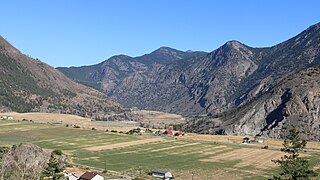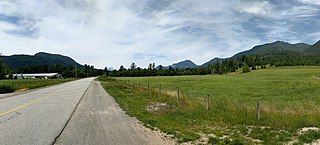
The Fraser Valley is a geographical region in southwestern British Columbia, Canada and northwestern Washington State. It starts just west of Hope in a narrow valley encompassing the Fraser River and ends at the Pacific Ocean stretching from the North Shore Mountains, opposite the city of Vancouver BC, to just south of Bellingham, Washington.

Mission is a city in the Lower Mainland of the province of British Columbia, Canada. It was originally incorporated as a district municipality in 1892, growing to include additional villages and rural areas over the years, adding the original Town of Mission City, long an independent core of the region, in 1969. It is bordered by the city of Abbotsford to the south and the city of Maple Ridge to the west. To the east are the unincorporated areas of Hatzic and Dewdney.

The Okanagan, also called the Okanagan Valley and sometimes the Okanagan Country, is a region in the Canadian province of British Columbia defined by the basin of Okanagan Lake and the Canadian portion of the Okanagan River. It is part of the Okanagan Country, extending into the United States as Okanogan County in north-central Washington. According to the 2016 Canadian census, the region's population is 362,258. The largest populated cities are Kelowna, Penticton, Vernon, and West Kelowna.

The Fraser Valley Regional District (FVRD) is a regional district in British Columbia, Canada. Its headquarters are in the city of Chilliwack. The FVRD covers an area of 13,361.74 km² (5,159 sq mi). It was created in 1995 by an amalgamation of the Fraser-Cheam Regional District and Central Fraser Valley Regional District and the portion of the Dewdney-Alouette Regional District from and including the District of Mission eastwards.

The Stó꞉lō, alternately written as Sto꞉lo, Stó:lô, or Stó:lõ, historically as Staulo or Stahlo, and historically known and commonly referred to in ethnographic literature as the Fraser River Indians or Lower Fraser Salish, are a group of First Nations peoples inhabiting the Fraser Valley and lower Fraser Canyon of British Columbia, Canada, part of the loose grouping of Coast Salish nations. Stó꞉lō is the Halqemeylem word for "river". The Stó꞉lō are the river people. The first documented reference to these people as "the Stó꞉lō" occurs in Catholic Oblate missionary records from the 1880s. Prior to this, references were primarily to individual tribal groups such as Matsqui, Ts’elxweyeqw, or Sumas.

The Douglas Ranges are a subrange of the Pacific Ranges of the Coast Mountains of the Canadian province of British Columbia, about 70 km (43 mi) east of downtown Vancouver, north of the Fraser River and between the valleys of Stave and Harrison Lakes. They are approximately 4,900 km2 (1,900 sq mi) in area. Their highest peak is Mount Robertson 2,252 m (7,388 ft), at the northwest limit of the range.

X̱á:ytem is an indigenous archaeological site and the name of a related museum run under the auspices of the Stoːlo people at Hatzic, British Columbia, Canada. X̱á:ytem is approximately 80 kilometres east of Vancouver on Highway 7. It is reached via the bridge at Mission, about 15 kilometres from the border with the US state of Washington. The site was designated in 1992 as a national historic site of Canada for its spiritual value to the Stoːlo people, as well as being one of the oldest discovered habitation sites at approximately 5000 years old. It was listed on the Canadian register of historic places in 2005. It is also known as Hatzic Rock National Historic Site of Canada.

Fountain is an unincorporated rural area and Indian reserve community in the Fraser Canyon region of British Columbia, Canada, located at the ten-mile (16 km) mark from the town of Lillooet on BC Highway 99, which in that area is also on the route of the Old Cariboo Road and is located at the junction of that route with the old gold rush-era trail via Fountain Valley and the Fountain Lakes.
Dewdney, originally named Johnson's Landing from 1884–1892, is an unincorporated community in the Central Fraser Valley of British Columbia, Canada, about 15 km east of the city of Mission. It was incorporated as a district municipality on April 17, 1892, including adjoining areas of Hatzic and Hatzic Island but the anticipated real estate boom on that island didn't pan out and economic damage from the Great Fraser Flood of 1894 led to the municipality's disincorporation on March 12, 1906. Another municipality eastwards, Nicomen, was incorporated in the same year but similarly later disincorporated. Though in the same school district as Mission, it and other adjoining rural areas did not join that municipality when offered. It is now represented as part of Electoral Area 'G' in the regional district government, which currently is the Fraser Valley Regional District.
Silverdale is a semi-rural neighbourhood of the District of Mission, British Columbia, Canada, located about 40 km east of Vancouver on the east bank of the Stave River at its confluence with the Fraser. Noted for its historic Italian Canadian community, its economy was farming, fishing and logging based until the general suburbanization of Fraser Valley life in the 1960s and 1970s. Of its Italian community, notable offspring include Phil Gaglardi, former BC Highways minister, and speed-skater Eden Donatelli. Silverdale is also notable as the site of Canada's first train robbery, by the "Gentleman Bandit" Billy Miner, and it is there he is supposed to have first used the polite "Hands Up!" in the course of the robbery.
Sumas Mountain, also referred to as Canadian Sumas to distinguish it from an identically named mountain just 10 km (6.2 mi) to the south in U.S. state of Washington across the border, is a mountain in eastern Fraser Lowland, in the Lower Mainland region of the Canadian province of British Columbia. It sits on the south bank of the Fraser River, west of the smaller Chilliwack Mountain across the Vedder River mouth, and serves as a geographic landmark dividing the Fraser Valley into "Upper" and "Lower" sections. Sumas Peak is an official name for the summit located on the south shore of the Fraser River in the Fraser Valley between Abbotsford and Chilliwack, British Columbia. Elevation 910 m (2,986 ft) above sea level, prominence 875 m (2,871 ft).

Durieu is an unincorporated predominantly farming community, located around five kilometers northeast of Mission, British Columbia, Canada in Area F of the Fraser Valley Regional District of that province's Lower Mainland at an elevation of between twenty and forty meters above sea level. Durieu falls mostly within zone 1 of the Agricultural Land Reserve. Sited in the middle of Hatzic Valley it has few services other than a store, gas station, feed co-op, defunct elementary school and community hall.
Bradner is a community within the City of Abbotsford, British Columbia, Canada, located in a rural northwest region of that city which also includes Mount Lehman. Bradner occupies a height of land above the Fraser River, immediately across which is the community of Silverdale, a part of the District of Mission, and Ruskin, on the border between Mission and Maple Ridge. On the floodplain below to the west is the Langley rural neighbourhood of Glen Valley, while on the floodplain to the east, which is called Matsqui Prairie, the nearest Abbotsford neighbourhood is Matsqui Village. Bradner was formerly part of the District of Matsqui, which in 1995 was amalgamated into the City of Abbotsford.
Matsqui is a former district municipality in British Columbia, Canada. It was incorporated in 1892 and merged with the district municipality of Abbotsford in 1995 to create the new City of Abbotsford. Matsqui used to be the western part of what is now Abbotsford. It had commercial growth in the Clearbrook area which then spilled over to Abbotsford.
Pekw'Xe:yles or Peckquaylis is an Indian reserve on the north bank of the Fraser River in Mission, British Columbia, Canada, located between Lower Hatzic Slough and D'Herbomez Creek. It sits on the former site of St. Mary's Indian Residential School 10.3 ha. in area, it was reinstated in June 2005 by Order in Council and is used by 21 Indian bands.

Hatzic Lake is an oxbow lake north of and draining into the Fraser River, immediately south of Hatzic Valley, and east of the benchland neighbourhood of Hatzic.
Hatzic Island is an island located in the centre of Hatzic Lake, an oxbow lake formation north of the Fraser River, on the east side of Mission, British Columbia, Canada.
The Leq'á:mel First Nation, formerly known as Lakahahmen First Nation, is a First Nations band government whose community and offices are located in the area near Deroche, British Columbia in the Fraser Valley region in Canada, about 12 kilometres east of the District of Mission. They are a member government of the Sto:lo Nation Chiefs Council, which is one of two tribal councils of the Sto:lo.
Keatley Creek is a left tributary of the Fraser River in the Glen Valley area of the Fraser Canyon in the Interior of British Columbia, Canada. Its outlet into the Fraser is between those of Pavilion and Fountain Creeks, approximately 16 miles upstream from the town of Lillooet; the next tributary southwards is the larger Sallus Creek.

The Hatzic Valley is the southerly, lowland portion of the Fraser Valley Regional District Electoral Area "F" of British Columbia's Lower Mainland. The valley was carved as a result of southward glacial action, being "centered along a low‐lying glacial trough that extends from Stave Lake to the Fraser Valley."












